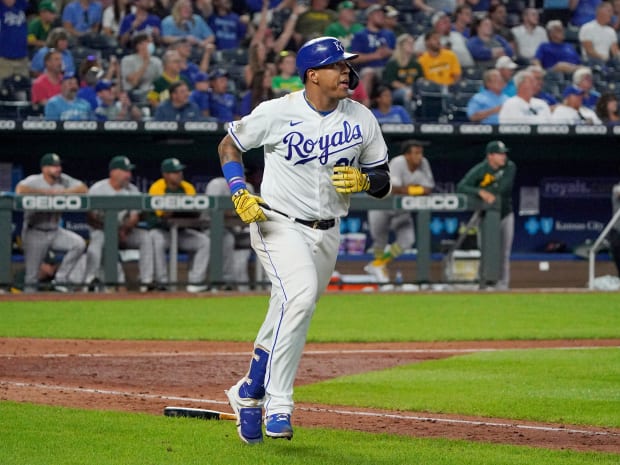At a time in his career when he should be slowing down, the 31-year-old Royals backstop is playing better than ever.
Welcome to The Opener, where every weekday morning you’ll get a fresh, topical column to start your day from one of SI.com’s MLB writers.
When Salvador Perez signed his $82 million, four-year contract extension with the Royals back in March, it was easy to believe that we had already seen the best of his baseball career. That is not to say that the extension was unreasonable or that there was no hope of continued solid play from Perez. It is only to say that catching is often terribly grueling, and there is an assumption for the sad, uncompromising bend of that aging curve, and Perez was about to turn 31. There is a script for how a catcher’s career should go after this point. And even if it goes slowly—gently—it almost only ever goes downward.
Now, of course, six months have passed. Perez is tied for the major-league home run lead with 45. With his next blast, he'll pass Johnny Bench for the most home runs hit by a catcher in a single season. He is hitting the ball harder than he ever has; his approach at the plate is yielding results that he has never seen before. This year may have seemed like a re-introduction for Perez—his first season under the new contract and his first full one since undergoing Tommy John surgery in 2019. But in another sense, it’s been an introduction, no prefix needed—he has never looked quite like this before.
With a few weeks left in the season, Perez has already achieved personal records for home runs (45 compared to a previous best of 27), RBIs (112 compared to 80), and Baseball-Reference WAR (5.0 compared to 4.2). His last few seasons have been something of a rollercoaster ride: After missing all of 2019 with the aforementioned Tommy John surgery, which can make for a particularly difficult comeback for catchers, Perez showed flashes of this revitalization in the pandemic-shortened 2020 season, albeit with significant questions about how much stock to put in that relatively small sample size. And now, in 2021, he’s having a career year.

Denny Medley/USA TODAY Sports
There isn’t a single easy answer to the question of what he has changed at the plate. One factor is simply that he’s hitting the ball harder than ever: Perez’s average exit velocity has cracked 92 mph for the first time, putting him within the top decile in MLB, something he had never achieved before. Another factor is his plate discipline. The catcher has always been a free swinger. (Perez’s walk rate has stayed so consistently low throughout his career that he posted one of the 10 lowest BB/K ratios in baseball for every single season he played from 2015 to 2020.) But he’s swung more often than ever this year. His 59% swing rate is higher than that of all but five other qualified hitters. All those swings have led to a career low in contact and a career high in strikeouts. But while letting himself swing so much, he’s increased the quality of contact that he makes when he does connect, and he’s clearly tapped into his power.
One last factor is his success with breaking balls. That’s not been a traditional strength for Perez—if anything, it’s been something of a weakness, particularly early in his career—but he’s changed that this season. He’s actually now more likely to get a hit on a breaking ball than on a fastball. (Pitchers seem to have noticed this and made an adjustment: While sliders and curves made up 40% of what they threw to Perez in 2020, that’s down to 35% in 2021.) Just look at the change in his performance on breaking stuff over the last few years:
Meanwhile, his traditional defensive strengths are intact. Perez has the highest caught-stealing percentage in the American League (41%—far above the league average of 23%). Of the 25 players who have caught more than 700 innings this season, he has the lowest total of errors and passed balls. (Of course, the less said about how he rates on framing metrics, the better—but that’s always been the case for him, and there’s more to catcher defense than framing, anyway.) And if he’s not quite the everyday workhorse backstop that he once had a reputation for being, he’s still logging significant time behind the plate, and with a bat like this, there are no qualms about letting him get a bit more time at DH, too.
If a career-best year like this is typically a memory-maker for a player, Perez’s case feels a bit different. It’s hard to imagine anything he could possibly do that would make him more of a hero to the franchise than what he pulled off in its World Series trips in 2014 and 2015. But therein lies the delight of the adjustments he has made this year. The news of his contract extension this spring was well-received because of its promise of the familiar—of the continued presence of a player who had been so beloved for so long. Perez has brought that simply by showing up every day. But with the way he’s played, he’s shown that even in the familiar, there’s room for surprises.
More MLB Coverage:
• The Ohtani Rules
• X-Factors for the AL Wild-Card Race
• Vlad Jr.'s Epic Year Shows the Limit of a Triple Crown
• Blue Jays' Bashing Offense Is the Answer to MLB's Woes